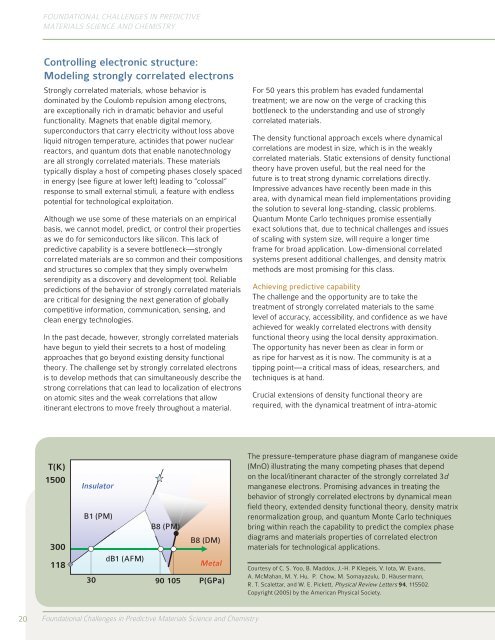Computational Materials Science and Chemistry ... - Office of Science
Computational Materials Science and Chemistry ... - Office of Science
Computational Materials Science and Chemistry ... - Office of Science
Create successful ePaper yourself
Turn your PDF publications into a flip-book with our unique Google optimized e-Paper software.
FOUNDATIONAL CHALLENGES IN PREDICTIVE<br />
MATERIALS SCIENCE AND CHEMISTRY<br />
Controlling electronic structure:<br />
Modeling strongly correlated electrons<br />
Strongly correlated materials, whose behavior is<br />
dominated by the Coulomb repulsion among electrons,<br />
are exceptionally rich in dramatic behavior <strong>and</strong> useful<br />
functionality. Magnets that enable digital memory,<br />
superconductors that carry electricity without loss above<br />
liquid nitrogen temperature, actinides that power nuclear<br />
reactors, <strong>and</strong> quantum dots that enable nanotechnology<br />
are all strongly correlated materials. These materials<br />
typically display a host <strong>of</strong> competing phases closely spaced<br />
in energy (see figure at lower left) leading to “colossal”<br />
response to small external stimuli, a feature with endless<br />
potential for technological exploitation.<br />
Although we use some <strong>of</strong> these materials on an empirical<br />
basis, we cannot model, predict, or control their properties<br />
as we do for semiconductors like silicon. This lack <strong>of</strong><br />
predictive capability is a severe bottleneck—strongly<br />
correlated materials are so common <strong>and</strong> their compositions<br />
<strong>and</strong> structures so complex that they simply overwhelm<br />
serendipity as a discovery <strong>and</strong> development tool. Reliable<br />
predictions <strong>of</strong> the behavior <strong>of</strong> strongly correlated materials<br />
are critical for designing the next generation <strong>of</strong> globally<br />
competitive information, communication, sensing, <strong>and</strong><br />
clean energy technologies.<br />
In the past decade, however, strongly correlated materials<br />
have begun to yield their secrets to a host <strong>of</strong> modeling<br />
approaches that go beyond existing density functional<br />
theory. The challenge set by strongly correlated electrons<br />
is to develop methods that can simultaneously describe the<br />
strong correlations that can lead to localization <strong>of</strong> electrons<br />
on atomic sites <strong>and</strong> the weak correlations that allow<br />
itinerant electrons to move freely throughout a material.<br />
T(K)<br />
1500<br />
300<br />
118<br />
Insulator<br />
B1 (PM)<br />
30<br />
dB1 (AFM)<br />
B8 (PM)<br />
90 105<br />
B8 (DM)<br />
Metal<br />
P(GPa)<br />
20 Foundational Challenges in Predictive <strong>Materials</strong> <strong>Science</strong> <strong>and</strong> <strong>Chemistry</strong><br />
For 50 years this problem has evaded fundamental<br />
treatment; we are now on the verge <strong>of</strong> cracking this<br />
bottleneck to the underst<strong>and</strong>ing <strong>and</strong> use <strong>of</strong> strongly<br />
correlated materials.<br />
The density functional approach excels where dynamical<br />
correlations are modest in size, which is in the weakly<br />
correlated materials. Static extensions <strong>of</strong> density functional<br />
theory have proven useful, but the real need for the<br />
future is to treat strong dynamic correlations directly.<br />
Impressive advances have recently been made in this<br />
area, with dynamical mean field implementations providing<br />
the solution to several long-st<strong>and</strong>ing, classic problems.<br />
Quantum Monte Carlo techniques promise essentially<br />
exact solutions that, due to technical challenges <strong>and</strong> issues<br />
<strong>of</strong> scaling with system size, will require a longer time<br />
frame for broad application. Low-dimensional correlated<br />
systems present additional challenges, <strong>and</strong> density matrix<br />
methods are most promising for this class.<br />
Achieving predictive capability<br />
The challenge <strong>and</strong> the opportunity are to take the<br />
treatment <strong>of</strong> strongly correlated materials to the same<br />
level <strong>of</strong> accuracy, accessibility, <strong>and</strong> confidence as we have<br />
achieved for weakly correlated electrons with density<br />
functional theory using the local density approximation.<br />
The opportunity has never been as clear in form or<br />
as ripe for harvest as it is now. The community is at a<br />
tipping point—a critical mass <strong>of</strong> ideas, researchers, <strong>and</strong><br />
techniques is at h<strong>and</strong>.<br />
Crucial extensions <strong>of</strong> density functional theory are<br />
required, with the dynamical treatment <strong>of</strong> intra-atomic<br />
The pressure-temperature phase diagram <strong>of</strong> manganese oxide<br />
(MnO) illustrating the many competing phases that depend<br />
on the local/itinerant character <strong>of</strong> the strongly correlated 3d<br />
manganese electrons. Promising advances in treating the<br />
behavior <strong>of</strong> strongly correlated electrons by dynamical mean<br />
field theory, extended density functional theory, density matrix<br />
renormalization group, <strong>and</strong> quantum Monte Carlo techniques<br />
bring within reach the capability to predict the complex phase<br />
diagrams <strong>and</strong> materials properties <strong>of</strong> correlated electron<br />
materials for technological applications.<br />
Courtesy <strong>of</strong> C. S. Yoo, B. Maddox, J.-H. P Klepeis, V. Iota, W. Evans,<br />
A. McMahan, M. Y. Hu, P. Chow, M. Somayazulu, D. Häusermann,<br />
R. T. Scalettar, <strong>and</strong> W. E. Pickett, Physical Review Letters 94, 115502.<br />
Copyright (2005) by the American Physical Society.

















